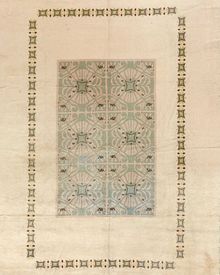Belgian Carpet
| Belgian Carpet | |
|---|---|
 | |
| General information | |
| Name | Belgian Carpet |
| Original name | فرش بلژیک، قالی بلژیک |
| Alternative name(s) | Belgian Rug |
| Origin | |
| Technical information | |
Belgian Carpet or Belgian Rug is one of the western rugs that woven in Belgium.
There is a large, contemporary production of powerloomed carpets in Belgium. Most of these are made in imitation of hand-knotted Near Eastern rug designs. From the thirteenth century, Flanders was famed for its tapestries and lace.[1]
History
Belgium is a country located in the northwestern region of continental Europe. During the Roman Empire Belgium was known as Belgica, and was inhabited by numerous tribes who bravely fought against Gaius Julius Caesar (100-44 BCE). Over the centuries Belgium was controlled by foreign armies of nations and kingdoms such as the Burgundians, Spain, Austria, France, and the Netherlands before regaining independence in 1830.
Beginning in the Middle Ages Belgium became a flourishing center of commerce, handicrafts, and culture. Belgium was known for farming and raising animals, especially sheep with high-quality wool. Sheep wool was increasingly used in weaving clothing and embroideries. During this period weaving was done in monasteries and by the women of a household. In the twelfth century the Belgian weaving industry grew dramatically and began to export its products by sea throughout Europe. During the thirteenth century the county of Flanders emerged as a leader in producing handicrafts, with weavers developing tapestries as wall hangings and decoration.
By the mid-fifteenth century tapestry production in Belgium became an important industry and was recognized by kingdoms and nobility throughout Europe. Tapestry designs were executed beautifully, with numerous subjects and settings: Gothic, biblical, mythological, historical (including battles), children at play, Millefleurs, and romantic and Hunting. Tapestries brought great prosperity to Belgium. Brussels became the leading center for tapestry weaving in the early sixteenth century and continued its dominance through the eighteenth century. Flanders and the cities of Oudenaarde, Tournai, and Arras (today in France) were other vital areas of production. Weavings made in Flanders are known as Flemish tapestries in the antique trade.
Production of knotted pile and handtufted carpets began in the mid-eighteenth century and continues to this day. In the old city of Tournai, the Royal Carpet Manufactory produced handknotted carpets on a limited scale during the nineteenth century. In this era machine-made carpet production also began and remains an important industry domestically and for export worldwide.
Belgian carpet designs include Oriental, European, Arts and Crafts, Art Deco, and other modern styles created by designers of the period. Tapestries and carpets are still made in notable cities such as Brussels, Saint-Nicolas, Bruges, Verviers, and Oudenaarde.[2]
References
Bibliography
- Abraham Levi Moheban. 2015. The Encyclopedia of Antique Carpets: Twenty-Five Centuries of Weaving. NewYork: Princeton Architectural Press.
- Peter F. Stone. 2013. Oriental Rugs: An Illustrated Lexicon of Motifs, Materials, and Origins. North Clarendon: Tuttle.